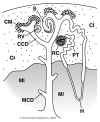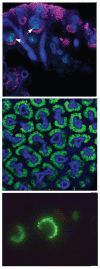Microdissection of the gene expression codes driving nephrogenesis
- PMID: 21220959
- PMCID: PMC3055652
- DOI: 10.4161/org.6.4.12682
Microdissection of the gene expression codes driving nephrogenesis
Abstract
The kidney represents an excellent model system for learning the principles of organogenesis. It is intermediate in complexity, and employs many commonly used developmental processes. As such, kidney development has been the subject of intensive study, using a variety of techniques, including in situ hybridization, organ culture and gene targeting, revealing many critical genes and pathways. Nevertheless, proper organogenesis requires precise patterns of cell type specific differential gene expression, involving very large numbers of genes. This review is focused on the use of global profiling technologies to create an atlas of gene expression codes driving development of different mammalian kidney compartments. Such an atlas allows one to select a gene of interest, and to determine its expression level in each element of the developing kidney, or to select a structure of interest, such as the renal vesicle, and to examine its complete gene expression state. Novel component specific molecular markers are identified, and the changing waves of gene expression that drive nephrogenesis are defined. As the tools continue to improve for the purification of specific cell types and expression profiling of even individual cells it is possible to predict an atlas of gene expression during kidney development that extends to single cell resolution.
Figures



References
Publication types
MeSH terms
Grants and funding
LinkOut - more resources
Full Text Sources
Research Materials
